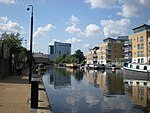Brentford railway station
1849 establishments in EnglandBrentford, LondonDfT Category E stationsFormer London and South Western Railway stationsLondon stations without latest usage statistics 1415 ... and 7 more
London stations without latest usage statistics 1516London stations without latest usage statistics 1617Rail transport stations in London fare zone 4Railway stations in Great Britain opened in 1849Railway stations in the London Borough of HounslowRailway stations served by South Western RailwayUse British English from August 2012

Brentford is a railway station in the town of Brentford, in Hounslow, London. It is on the Hounslow Loop Line and in Travelcard Zone 4. The station and all trains serving it are operated by South Western Railway. It was the main station for Brentford F.C.'s former ground Griffin Park, 400 metres east. The modest High Street of the suburb of Brentford (characterized by wide-ranging businesses and light industrial parks) is 300 metres south-east.
Excerpt from the Wikipedia article Brentford railway station (License: CC BY-SA 3.0, Authors, Images).Brentford railway station
Downside Road, London
Geographical coordinates (GPS) Address Nearby Places Show on map
Geographical coordinates (GPS)
| Latitude | Longitude |
|---|---|
| N 51.4875 ° | E -0.3096 ° |
Address
Brentford Station Car Park
Downside Road
TW8 8DT London (London Borough of Hounslow)
England, United Kingdom
Open on Google Maps








